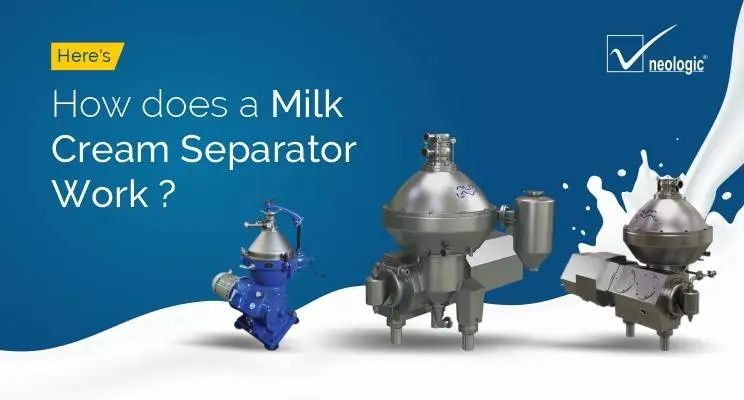
A Milk Cream Separator, as the name suggests, is a device used to ‘separate’ cream from whole milk, dividing the whole milk into Skim Milk and Cream.
Cream and skim milk have dissimilar densities, and therefore under the impact of gravity, they tend to get separated.
A simple test can prove it! Just leave the cow’s milk out for 24 hours at room temperature, and you will see how cream gathers at the top.
How Does a Centrifugal Milk Cream Separator Function?
The use of centrifugal force in a cream separator machine amplifies the cream separation from milk. One centrifugal milk separation unit contains conical disks spinning in a bowl or drum at the speed of around 6,000 to 10000 revolutions per minute, depending on the structure and operating theory of separation.
A centrifugal force equivalent to thousands of times the normal gravitational force is created on the whole milk which is moving through the conical disks. Fat globules being the lighter part of the milk move to the heart of the drum, while the heavier skim milk moves to the outer sides as they get separated from the fat component. This is the process of cream-skimming.
Important Characteristics to Be Considered in a Milk Fat Separator
- Efficiency:
A high-quality centrifugal cream separator is assumed to remove skim milk up to 0.05% of fat in skim milk.
- Ability:
The capacity of a milk cream separator is the quantity of milk it is willing to pass through in a single hour while achieving the required skimming efficiency.
- Power supply:
These milk cream separators are essentially electrically driven by a motor. However, some small capacity farm models that used to be available in the past were manually driven. or controlled manually.
Also read, Definitive Guide to Milk Standardization
Special Considerations That Influence Milk Separation
- Milk temperature:
The optimal temperature required for milk separation is around 45℃.
- Several volumes of milk fat:
More quantity of milk fat implies more quantity of cream after separation.
- Price of the milk:
The small and medium capacity is of the solids (dirt, foreign particles) retaining separators, as against the larger capacity continuous operation self-cleaning Separators, Hence for the solids retaining separators, the separators need to stop after every few hours, the separator production is stopped so that separator bowl along with the disc stacks is washed to remove dirt, foreign particles, soil, slime and other external matter collected in the bowl that has been removed from the milk and clarified. The exact time needed for continuous separation changes depending on the initial quality of the milk being separated and how it has been handled at the farm level.
- Neologic Engineers Recommendation:
As dairy plant machinery manufacturers, for small and medium capacity lines having solids bowl separators we recommend the use of two separators if continuous uninterrupted operation is needed. Then, you can ensure continuous processing of the milk and its centrifugation without interruption. The second separator can get to work when you clean the first one.
Types of Milk Separation Process
- Organic Vs Pasteurized:
The process of obtaining cream from raw milk doesn’t differ from the process of pasteurization. However, in organic natural milk, fat is not removed, as milk is to be consumed in its natural form.
- Cow Vs Goat:
Goat milk has a lighter microstructure due to its fatty globules. So, the normal separation of cream kept in a vessel, from goat milk takes more time than that of the cream from cow’s milk. But when a disk bowl centrifuge is used, all types of milk are well separated.
So, if you run a dairy plant that intends to separate or standardize milk regularly, a centrifugal separator is precisely what you need.
Take a look at Neologic Engineers range of Alfa Laval make Milk Cream Separators to find high-quality and time-tested devices ideal for your purposes.